VFX supervisor Sue Rowe and animation director Erik de Boer at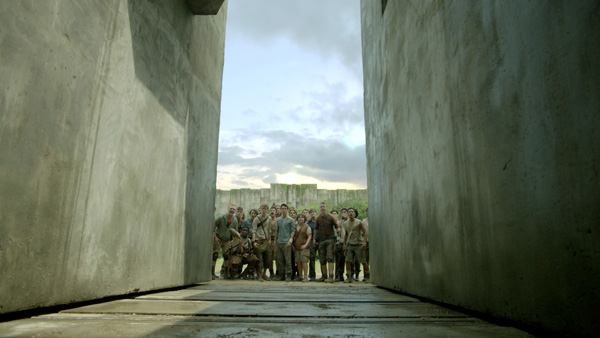
Method Studios take on environments, complex simulations and
vicious Grievers for ‘The Maze Runner’.
Method Unravels the Maze with a New Creature Pipeline |
| Method Studios’ Vancouver studio handled all visual effects in ‘The Maze Runner’, which demanded environment work, numerous simulations, green and blue screen replacements and, most important, a terrifying new breed of creatures called Grievers. VFX supervisorSue Rowesaid, “We knew that the producers at 20th Century Fox were taking a chance on us. This film’s story and our effects hinged on the Grievers, but up until now Method hasn’t really had a chance to demonstrate its creature work skills or develop a creature pipeline. |
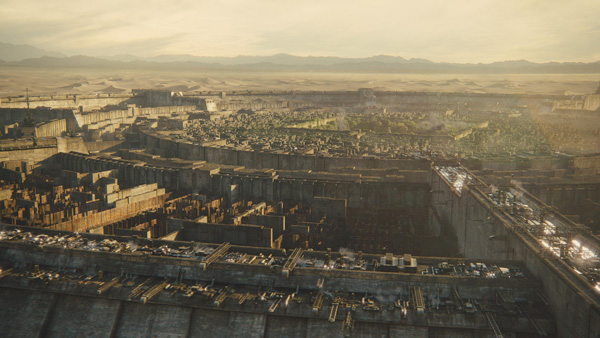 |
|
SurroundedThe producers were enthusiastic about the team, but wanted to see a completely modelled, fully rigged and animated Griever by the end of the shoot, which was only to last nine or ten weeks. For this reason, Sue moved between the set and the studio during filming while her co-VFX supervisorEric Brevigstayed out at the location for the duration. The shoot took place in and around Baton Rouge, Louisiana, where one of the challenges was the need to use blue and green screen extensively and very flexibly. In this story, a group of boys have been pulled from their homes and their memories erased. They must live together as a community, trapped at the centre of a huge, stone Maze. Deep inside this Maze, the Grievers live. |
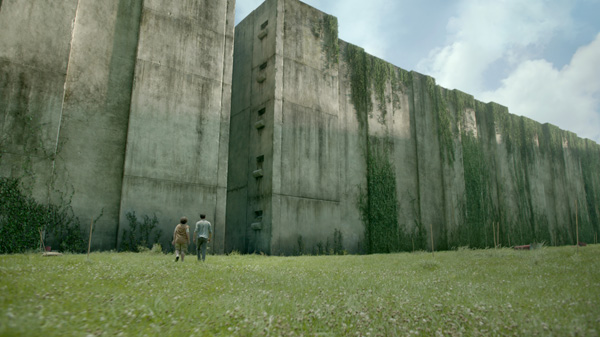 |
|
One of the primary sets is the Glade in the middle of the Maze where the boys are living. The set was an open field, and the crew operated from the middle with a 16ft set piece of the wall positioned about 300ft away. The field was actually already surrounded by trees, so the team used these as a rough guide and replaced them with their CG walls, handled in some shots with blue screen and in others with rotoscoping. |
 |
Living Walls“Lighting the walls correctly was crucial for realism and continuity. We had to think like cinematographers and use the story for our cues. For example, these walls open each day at sunrise and sunset, which made two ideal lighting cues for the lighters. We placed long shafts of light glancing down the walls’ surface whenever it was suitable, which also helped enhance the scale,” Sue said. Due to its importance for drama as well as realism, she and the team had to look at lighting from both a physically correct point of view, and from an artistic point of view to include expectations and assumptions relating to the story. While the walls were a fairly straightforward build in Maya and textured in MARI, a major technical challenge was the growth of ivy that covered them. Any CG ivy needed to match the practical props provided at the base of the walls, which Method’s team extended digitally up to the top of the walls. “We had several different factors to consider before deciding on our approach to it. Trying to populate the environment with enough geometry would have been time-consuming, very difficult to light and render, and not very flexible,” Sue explained. |
 |
|
To avoid creating shots that combined assets lit and rendered both in Mantra and in V-Ray, the artists exported much of their Houdini work using a script they had written to make it possible to render Houdini output in V-Ray. In one such scene a Griever tumbles down from where it is lurking on a wall, bringing lots of the ivy down with it. Because the ivy had been generated in Houdini and rendered in Mantra, while the Griever was built in Maya and lit in V-Ray, the ivy was exported from Houdini using their script and all of the CG could be rendered in V-Ray. |
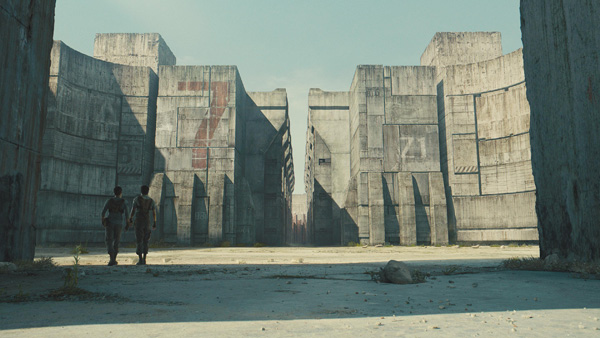 |
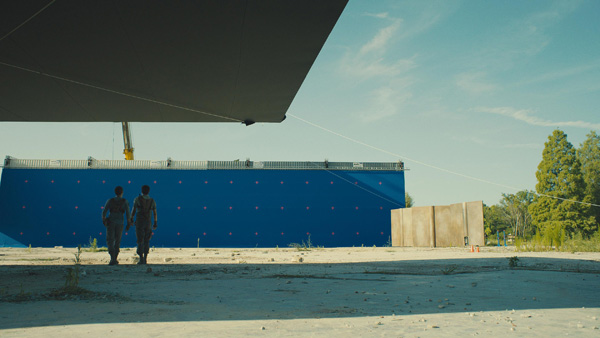 |
Controlling Forces‘The Maze Runner’ is director Wes Ball’s first feature film. He is known mainly for his work as a graphic artist, visual effects artist and short film director. For an exciting, fast-paced sequence in which the heroes Thomas and Minho race through the Maze as its huge walls shift violently around them, threatening to seal them inside, Wes supplied some of his own previs to show his ideas about the action and the movements of the walls. Previs was essential to prevent high-action sequences like this from falling into chaos. With the team’s input, the sequence soon developed from sliding and rotating motions, to walls tumbling down, a ravine opening and clouds of dust flying up. “Taking cues from real world destruction, from earthquakes to collapsing buildings, the final look was achieved with multiple layers in Houdini, starting with a ‘crack’, then fine powder rising up resembling hydraulic air escaping, followed by sandy fragments, small stones – and then huge rocks breaking away and falling around the boys,” Sue described. |
 |
|
Heart of the ActionThe Grievers are at the heart of this story, creating fear and tension, and were the focus of Method’s work. Their essential nature is a deadly, six-legged mash-up of heavy machinery with organic parts.Erik de Boerjoined Method to work on this project as animation director just after the team received concepts for the Grievers from concept artistKen Barthelmy. “They were inspiring sketches for us – very dynamic poses of a mechanical-organic creature. The shoot still hadn’t got underway but we needed to determine the size relative to the characters in advance, and start on the build,” Erik said. |
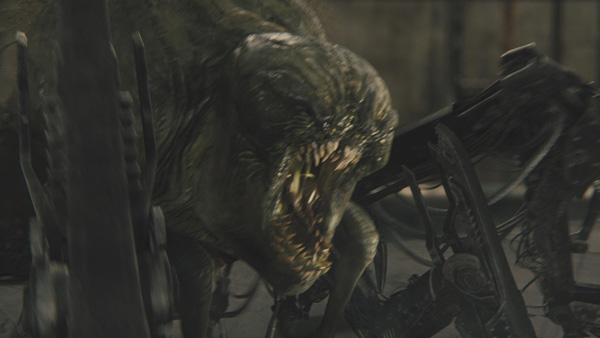 |
|
Sue said, “To develop the Grievers enough to build and animate them, we decided to look at reference of cranes and pneumatic drills. The animation was going to be tricky, partly because their large, heavy bodies needed to move with speed and agility along the narrow corridors of the Maze. The corridors were only 8 to 12 feet wide but their legs could actually splay 15ft apart. We introduced a kind of hydraulic, telescoping mechanism so the legs could extend or shrink as they ran along to accommodate the available space.” Hydraulics and Pneumatics“Once you move into 3D, you can experiment with the design and specific details. For example, we designed a special mechanism for each joint, offsetting the pivot points to make the motion more distinctive,” said Erik de Boer. “It was also at this stage that we developed the telescoping legs, so they could gallop out across the Glade area as well as negotiate the constricted Maze corridors. |
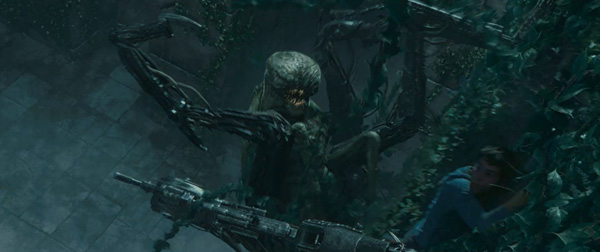 |
|
Overall, they wanted to design an interesting silhouette to work from, adding hydraulic hoses swinging from its back and, running down its spine toward its metal tail, a line of tiny knives that flick up and down, catching the light. The riggerVictor Barbosadevised a procedural zipper-like method to control those knives that sourced pre-made, keyframed motions. This gave it a centipede feel and allowed the animators to express emotion by drawing in or expanding the Griever’s pincer-like tail. Organic MachineryThey always looked for a clear, graphical quality in all the poses and watched how the design came across on screen. Including strong negative space helped the viewer understand how they were built. Erik said, “Visually, of course, these inner mechanical stories are still concealed except for the hoses, which tensed up at the moment the actuators kicked in and the legs fired. We tried to sell its mechanics in that way. Our idea for the jackhammers was that they helped the Grievers grasp onto the rock walls and floor – causing the falling leaves and crumbling walls whenever they contacted the set, improving the integration.” |
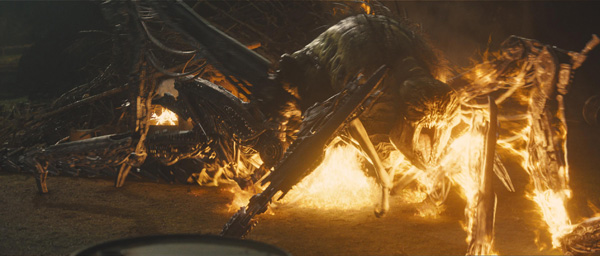 |
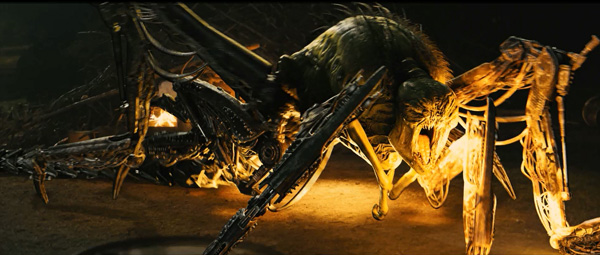 |
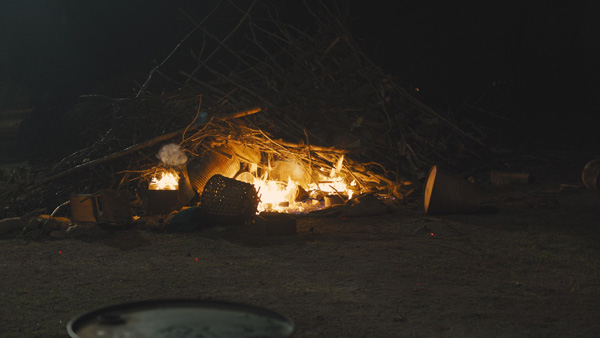 |
Animation leadDan Mizuguchihandled a shot of a Griever after one of the characters throws flames at it. Pained and distracted, the creature recovers and returns to the chase. Space and camera moves were limited but the final shot comes through with heavy FX fire. |
|
Erik was especially interested in mixing machine moves with organic motion. “As much as the dynamic concept drawings, instinct tells you that these will be very dynamic creatures,” he said. ”We started looking for the conventional sorts of reference from nature – ants, cockroaches, centipedes and other creepy crawlies but the result was too insect-like. So we also turned to hexapods and similar six-footed machines, layering in that awkwardness as far as possible, even slight clumsiness to give the kids some hope of somehow overcoming them. “Nevertheless, they are well-adapted to the Maze environment and had to be agile enough to pose a threat, move at speed and climb walls. AnimatorStephen Cleedevoted a lot of R&D work to figuring out how these creatures locomote. It was a fun, inner conflict to engineer!” Creature TeamSue relied on the creature effects team to visualise all her ideas - the Griever’s heaving chest for example, the scales over its underbelly, and the quivering layer of fat over its back. The secondary jiggle associated with soft tissues usually needs a secondary simulation, resulting from acceleration and deceleration, layered on top of motion to make it more believable. All of these required simulations. |
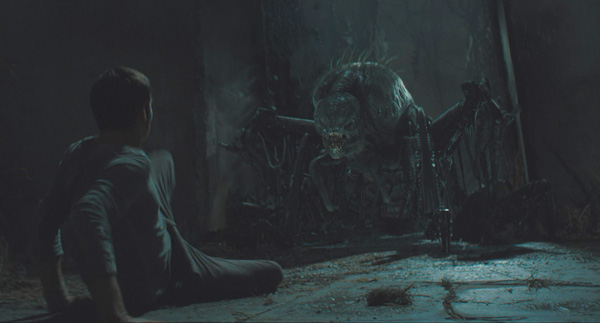 |
 |
|
James’ understanding of weight displacement and fat in motion actually earned him a Scientific and Technical Award from the Academy of Motion Picture Arts and Sciences for his work on the Gobelin King in ‘The Hobbit’ films. He has continued to help Method’s team build other creatures for the upcoming film, ‘Night at the Museum’. Weight and SpeedThe Grievers’ weight and speed were two characteristics the team worked on quite hard. The creatures had to feel massive and heavy to the audience to make them seem more dangerous, but also move as fast as or faster than Thomas and his friends. |
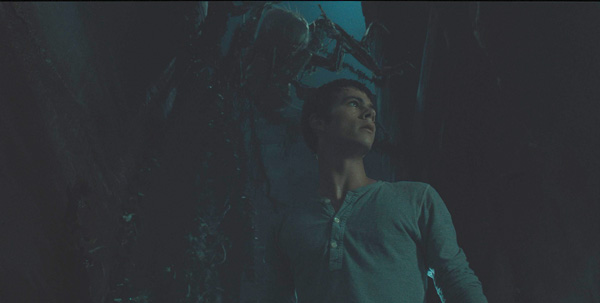 |
|
Thus when they skid around corners, brush up against the ivy or impact with the walls and floor, they cause damage such as falling leaves and crumbling rock. People are intuitively aware of how objects of different weights and materials interact – they might not notice the subtle impact effects but would miss them if they had been left out. Jumping from Set to AnimationThe group of kids’ final attack on the Grievers was an interesting challenge, partly because it was a high action sequence shot entirely on a blue screen stage. Stunt actors in blue, brandishing blue sticks stood in for the creatures, a 360° blue screen encircled the stage, and only the floor and the actors are captured in camera. As the kids enter the space the Grievers turn and try to attack them. But the boys fight back. |
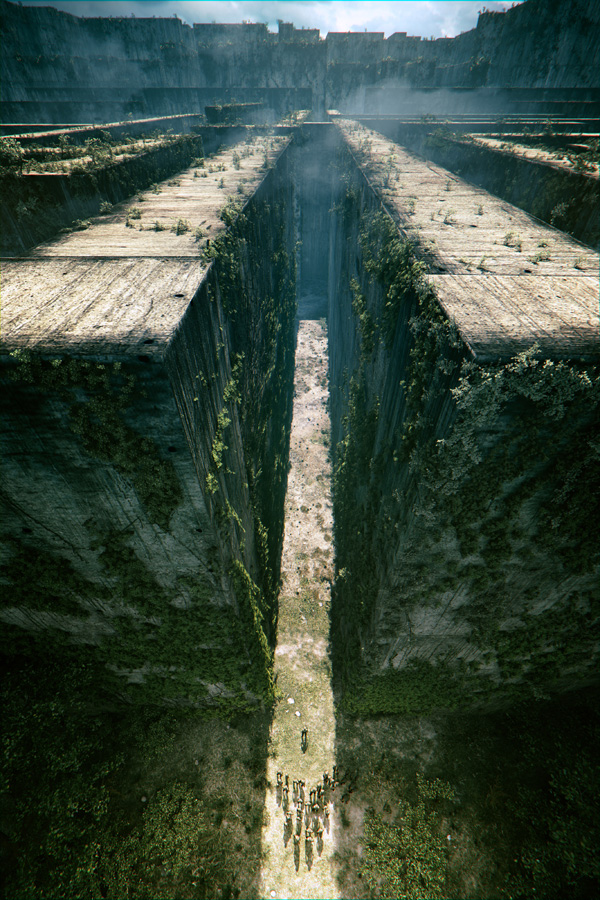 |
|
Sue said, “At first the young actors were hesitant but once the director got them going, a series of great fight performances were captured. The animators worked hand-in-hand with the editors in post to produce the exciting battle sequence. Using animated CG to make the best of the fight moves work, they applied some reverse engineering to make animation play off the live action performances.” Quality of MotionErik had joined Method specifically to work on this project, and found it exciting to return to off-the-shelf software and work on tools alongside a very competent team of animators. But in fact, one of the first changes they made was to the workflow – specifically, they would let the animators indicate their work preferences for improving the quality of motion on a character, create a fast way to share their work, put it into a cut, watch it in sequence, evaluate, come back with a fresh eye - and iterate. Erik said, “Regarding the pipeline, fortunately, animation remains an island in some ways within the rest of a facility’s pipe, with fewer dependencies on other departments. Victor Barbosa, the rigger, built a powerful and intuitive rig that drove the complex telescoping legs on the Grievers, fully functional with IK/FK switching. It was a great way to switch to different levels of detail. Another of the creature artistsPaul Jordandid excellent simulations on the hoses and other effects. |
 |
|
Animating to CameraErik always aims to go on set on projects, finding it is vital to keeping CG animations aware of the context and fitting them into the full production. “On set, we have the chance to think about giving the camera the appropriate level of energy, making the framing and composition suitable for compositing the creatures in. In Baton Rouge, I was observing how the production managed this large group of young actors, energetically fending off the stunt team,” he said. “In post we went on to add overriding camera moves and so on to make sure the camera followed not only live action characters but also the CG Grievers when they came galloping into view and collided with the kids. You always have believability issues with blue screen shots especially, but having been on set gives you more cinematic freedom to design your camera takeovers and extra CG shots to really convey the feeling that the cameraman was out there with the monsters - and vice-versa.” www.methodstudios.com Words: Adriene Hurst |


















